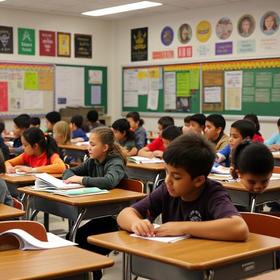Wescove Elementary School serves 219 students in grades Kindergarten-2.
The percentage of students achieving proficiency in math is 53% (which is lower than the California state average of 56%). The percentage of students achieving proficiency in reading/language arts is 47% (which is lower than the California state average of 54%).
The student-teacher ratio of 20:1 is lower than the California state level of 21:1.
Minority enrollment is 97% of the student body (majority Hispanic), which is higher than the California state average of 80% (majority Hispanic).
Quick Facts (2025-26)
- Grades: Kindergarten-2
- Enrollment: 219 students
- Student-Teacher Ratio: 20:1
- Minority Enrollment: 97%
- Math Proficiency: 53%
- Reading Proficiency: 47%
- Source: National Center for Education Statistics (NCES), CA Dept. of Education
Top Rankings
Wescove Elementary School ranks among the top 20% of public schools in California for:
Category
Attribute
Community Size
School Overview
Wescove Elementary School's student population of 219 students has declined by 8% over five school years.
The teacher population of 11 teachers has stayed relatively flat over five school years.
Grades Offered
Grades Kindergarten-2
Total Students
219 students
Gender %
Total Classroom Teachers
11 teachers
School Calendar
Campus Size
5 acres
School Mascot
Wallaby
School Rankings
The diversity score of Wescove Elementary School is 0.42, which is less than the diversity score at state average of 0.63. The school's diversity has stayed relatively flat over five school years.
Math Test Scores (% Proficient)
(09-10)53%
56%
Reading/Language Arts Test Scores (% Proficient)
(09-10)47%
54%
Student-Teacher Ratio
20:1
21:1
American Indian
n/a
1%
Asian
18%
12%
Hispanic
74%
56%
Black
3%
5%
White
3%
20%
Hawaiian
n/a
n/a
Two or more races
2%
6%
All Ethnic Groups
Eligible for Free Lunch
64%
54%
Eligible for Reduced Lunch
12%
8%
School Statewide Testing
School District Name
Source: National Center for Education Statistics (NCES), CA Dept. of Education
School Notes
- School Mascot: Wallaby
Profile last updated: 02/09/2025
Frequently Asked Questions
What percent of students have achieved state testing proficiency in math and reading?
53% of students have achieved math proficiency (compared to the 56% CA state average), while 47% of students have achieved reading proficiency (compared to the 54% CA state average).
How many students attend Wescove Elementary School?
219 students attend Wescove Elementary School.
What is the racial composition of the student body?
74% of Wescove Elementary School students are Hispanic, 18% of students are Asian, 3% of students are Black, 3% of students are White, and 2% of students are Two or more races.
What is the student-teacher ratio of Wescove Elementary School?
Wescove Elementary School has a student ration of 20:1, which is lower than the California state average of 21:1.
What grades does Wescove Elementary School offer ?
Wescove Elementary School offers enrollment in grades Kindergarten-2
What school district is Wescove Elementary School part of?
Wescove Elementary School is part of West Covina Unified School District.
In what neighborhood is Wescove Elementary School located?
Wescove Elementary School is located in the Walnut Valley neighborhood of West Covina, CA. There are 15 other public schools located in Walnut Valley.
School Reviews
5 10/10/2025
so far everyone has been very nice to my child in wescove elementary. the teachers are nice here.
Review Wescove Elementary School. Reviews should be a few sentences in length. Please include any comments on:
- Quality of academic programs, teachers, and facilities
- Availability of music, art, sports and other extracurricular activities
Recent Articles

How Public Schools Support Students on Free / Reduced-Lunch Programs
Explore how U.S. public schools support students eligible for free or reduced-price lunch through nutrition, academic, and wraparound services in 2025.

Hidden Costs of Public Schools: Fees, Supplies & Extras
Explore the hidden costs in public schools—fees, supplies, extracurriculars—and how parents can plan for them in 2025.

Public School Funding 2025: What Families Should Know
Essential insights on public school funding in 2025—how it works, what’s changing, and what families should know to stay ahead.





